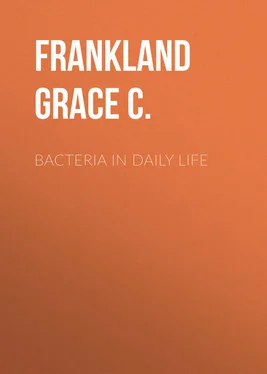Grace Frankland - Bacteria in Daily Life
Здесь есть возможность читать онлайн «Grace Frankland - Bacteria in Daily Life» — ознакомительный отрывок электронной книги совершенно бесплатно, а после прочтения отрывка купить полную версию. В некоторых случаях можно слушать аудио, скачать через торрент в формате fb2 и присутствует краткое содержание. Жанр: Медицина, foreign_antique, foreign_prose, на английском языке. Описание произведения, (предисловие) а так же отзывы посетителей доступны на портале библиотеки ЛибКат.
- Название:Bacteria in Daily Life
- Автор:
- Жанр:
- Год:неизвестен
- ISBN:нет данных
- Рейтинг книги:4 / 5. Голосов: 1
-
Избранное:Добавить в избранное
- Отзывы:
-
Ваша оценка:
- 80
- 1
- 2
- 3
- 4
- 5
Bacteria in Daily Life: краткое содержание, описание и аннотация
Предлагаем к чтению аннотацию, описание, краткое содержание или предисловие (зависит от того, что написал сам автор книги «Bacteria in Daily Life»). Если вы не нашли необходимую информацию о книге — напишите в комментариях, мы постараемся отыскать её.
Bacteria in Daily Life — читать онлайн ознакомительный отрывок
Ниже представлен текст книги, разбитый по страницам. Система сохранения места последней прочитанной страницы, позволяет с удобством читать онлайн бесплатно книгу «Bacteria in Daily Life», без необходимости каждый раз заново искать на чём Вы остановились. Поставьте закладку, и сможете в любой момент перейти на страницу, на которой закончили чтение.
Интервал:
Закладка:
The classical investigations of Pasteur on the attenuation of bacterial viruses such as those of chicken-cholera and anthrax, and his elaboration of a method of vaccination with these weakened viruses whereby the power of the disease over its victim is removed or modified, are too well known to require repetition here. The success which followed Pasteur's researches in this direction led him to undertake that great and difficult task, the prevention of rabies in the human subject – a task well-nigh superhuman in its demands, and one which only he could accomplish in whose life the pregnant words of a modern writer found expression – "il ne suffit pas de posséder une vérité, il faut que la vérité nous possède." The victory over this disease, which crowned a long life replete with brilliant achievements, has been universally recognised, and numerous institutes have arisen in all quarters of the globe for extending the benefits of this discovery for the relief of suffering humanity. These Pasteur or bacteriological institutes also furnish highly important centres where original research work of various kinds is carried on, and the stimulus which has thus been given to experimental science in the remotest parts of the world cannot be overestimated.
Methods for the prevention of disease have, however, not been confined to the elaboration and employment of modified or weakened bacterial viruses; the subject has been still more recently approached from another and quite different side. This new departure we also originally owe to France, although its practical development has been worked out in Germany.
It was in 1888 that two Frenchmen, Richet and Héricourt, communicated a memoir to the Comptes rendus of the Academy of Sciences, describing the curious results they had obtained with rabbits purposely infected with a disease microbe, the Staphylococcus pyosepticus . Some of the rabbits died after being inoculated with this micro-organism and some remained alive, and they proceed to point out how it was that such different results were obtained. Before the inoculations were made some of the animals received injections of blood taken from a dog, which a few months previously had been infected with this same microbe, but had recovered. The rabbits which received the dog's blood all survived the inoculations, whilst those which did not, succumbed in every case to the action of the Staphylococcus pyosepticus . So struck were the authors by these remarkable results that they repeated them, and their further investigations fully confirmed those originally obtained, proving that they were not "un fait exceptionnel."
Here we have the first steps in the direction of serum-therapy, that new treatment of disease which during the last few years has been so prominently before the public in the cure of diphtheria, tetanus, and other maladies, and for the development of which we owe so much to the labours of Behring, Roux, Kitasato, and other investigators.
The astounding fact that the blood of animals which have been trained to artificially withstand a particular disease becomes endowed with the power of protecting other animals from that disease is only in the earliest stages of its application. The results, however, which have already been accomplished are of so encouraging a character that the hope is justified that serum-therapy is destined to revolutionise the treatment of disease. One of the latest uses which has been made of this method of combating disease is the employment of serum for the cure of bubonic plague. During the recent outbreak of plague in India, Yersin, formerly a student and assistant at the Paris Pasteur Institute, was despatched to India to superintend the administration of this new remedy, and the serum he employed was that derived from horses which had been subjected to, and had recovered from, inoculations with the plague bacillus. The treatment of snake bites by means of curative serum will be dealt with in more detail later on; it only remains to cite it here as another instance of the success which is attending the new methods of protection against disease.
Another and highly ingenious application of serum has been brought forward by Pfeiffer, Gruber, Widal, and others. This is the so-called sero-diagnosis of disease, and has been employed already with success in the identification of typhoid fever as such. The method sounds simple in the extreme, and consists in taking a few drops of blood from a patient supposed to be suffering from typhoid fever and mixing them with a recent cultivation in broth of genuine typhoid bacilli. If the blood is derived from a typhoid-infected person, then the bacilli should exhibit a curious and characteristic appearance when examined under the microscope. Instead of moving about as individuals in various parts of the microscopic field, they should be seen gathering or clumping together in numerous small heaps, their movements the while becoming paralysed.
The State Board of Health of Massachusetts has recently taken up the official sero-diagnosis of typhoid fever, and issues in response to applications a simple outfit with instructions how to collect specimens of blood and a form which they request shall be returned filled in with all the details concerning the case under observation. Only a few drops of blood are required for the examination, and these before being despatched to the State Laboratory are collected on slips of paper and allowed to dry. If the addition of this suspected blood in the proportion of one to twenty to a young and vigorous culture of typhoid bacilli succeeds in paralysing their movements, producing the characteristic clumping together or agglutination of the bacilli, then the reaction is considered positive and the case one of typhoid fever.
That, however, some risk attends the placing of too implicit a reliance on this method of diagnosis alone is evident from the fact that a negative reaction, or in other words, absence of all agglutinising phenomena, is sometimes associated with blood throughout what is beyond all question a well-defined case of typhoid fever, whilst in the first week of this disease the test is frequently negative in character. Rouget, who has made a very careful inquiry into the value to be attached to the sero-diagnosis of typhoid fever, states that he has found in a large number of examinations of blood derived from undoubted typhoid patients the agglutination phenomena fail altogether; it is, therefore, not surprising that the sero-diagnosis of this disease is still the subject of much discussion and investigation.
An interesting example of how particular serums may be employed for the detection of particular poisons has been furnished by Dr. Calmette. In some districts of India the natives have an ugly custom of wreaking their vengeance on their enemies by poisoning their cattle, and to effect this both expeditiously and secretly they employ subtle poisons which they know can only be detected with great difficulty. Serpent venom is a favourite substance, whilst abrine, a highly toxic vegetable poison, is another. The method adopted for the application of this abrine is highly original, and consists in taking small bits of wood shaped like miniature clubs, so diminutive in size that they can be concealed in the hand. In the head of the club small holes are bored, and tiny pointed rodlets of a hard greyish substance are fitted into them. Armed with these crude instruments, the natives scratch the cattle in several places, and, although but little external sign of injury is to be seen, the rod-points penetrate the skin and are broken off, and the poison is left to work its lethal way through the animals' system. Mr. Hankin forwarded some of these broken-off rod-points to Dr. Calmette for the identification of their composition, and he diagnosed the material employed as abrine in the following original manner. He first introduced some of this rod material into animals, and found that their symptoms were suggestive of abrine poisoning. To confirm his suspicions, however, he took some more of this rod material, and, before inoculating it into animals, he mixed it with serum derived from animals which had been artificially rendered immune to abrine poison. Instead of the animals into which this mixture of serum and "rod material" had been introduced dying like the previous ones, they remained alive. Had the "rod material" consisted of some poison other than abrine, the abrine serum would not, according to Dr. Calmette, have negatived its action, and it has thus been indicated how protective serums may be successfully employed for the detection of poisons.
Читать дальшеИнтервал:
Закладка:
Похожие книги на «Bacteria in Daily Life»
Представляем Вашему вниманию похожие книги на «Bacteria in Daily Life» списком для выбора. Мы отобрали схожую по названию и смыслу литературу в надежде предоставить читателям больше вариантов отыскать новые, интересные, ещё непрочитанные произведения.
Обсуждение, отзывы о книге «Bacteria in Daily Life» и просто собственные мнения читателей. Оставьте ваши комментарии, напишите, что Вы думаете о произведении, его смысле или главных героях. Укажите что конкретно понравилось, а что нет, и почему Вы так считаете.












